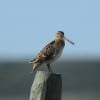 By Jim Stevenson
By Jim Stevenson
Our Alaska trip is winding down and it is no doubt the best birding trip I’ve ever run! I mean, we saw nearly everything! Many Photos to follow once the Great Plains are over. This Gallery is many of the birds from our May Great Plains trip. Enjoy! Have a good Monday and week.
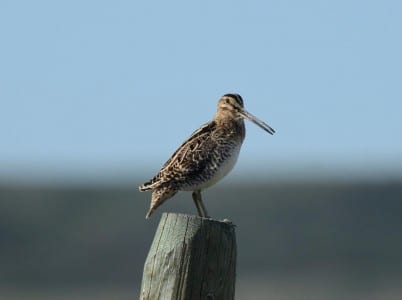
Shorebirds (Charadriiformes) are a huge group of water birds, mostly with long bills and legs. They are well-adapted for life around the water but a surprisingly large number live in dry areas, though some only in the breeding season. Of course, this helps, as quite a few of our shorebirds nest on the Arctic Tundra. Sandpipers are the largest group of shorebirds, and one of the best known is the snipe. They’ve undergone one of the AOU’s name changes, so it’s now the Wilson’s Snipe, named for the late great American ornithologist, Alexander Sni, er Wilson. Male snipe have a courtship flight that’d make a fighter pilot blush, flying hundreds of yards high in the air and making whizzing noises as air passes briskly through his wings.
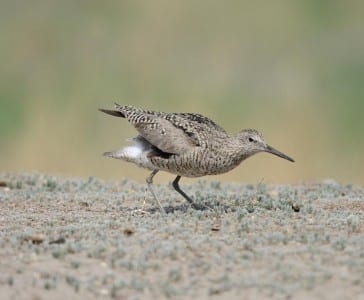
The very same Willets that cover our beaches fall through spring with their unexciting colors leave in late spring for the Plains, armed with barring supreme. These birds, which eat swimming crabs and such for eight months, suddenly shift to far different forms of food for their hungry chicks. Location identifies this bird as a Western Willet but if it didn’t, the long, slender bill would. There’ ll be a pdf on these two when the AOU finally gets around to separating them into two species.
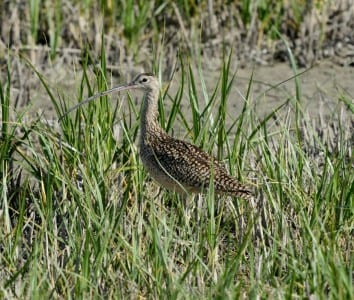
Long-billed Curlews are well-named, with these females having bills that look like they were once a clothes hanger. Their loud, cur-LEW calls ring over the short-grass prairie with their godwit neighbors, both grabbing arthropods for a protein treat for the kids.
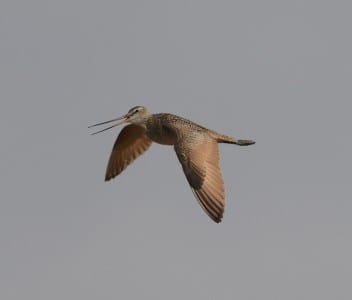
Zipping past is the Marbled Godwit, the curlew’s partner in short grass prairies. With an upturned bill, instead of the curlew’s decurved schnozzle (that’s a word!), they work over the arthropods pretty well. Their brown color is great camouflage and their long bills enable them to watch for danger while feeding. But WHO is the third member of this trio of large, brown shorebirds? It is the…
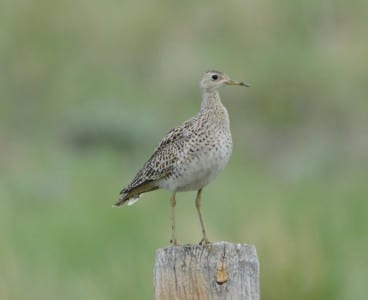
The Upland Sandpiper. We get these in the migration along the Gulf Coast but they nest in the grassy areas of the mid to western parts of our Country’s fields and meadows. They are most often seen on fence posts and have secretive nests. Their short bill once gave them the name Upland “plover” but the AOU realized they were obviously a sandpiper
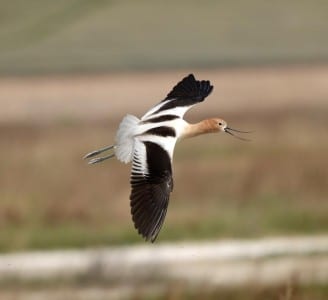
We think of avocets as Gulf Coast birds but they nest in the western states near water. This is a female; note he upturned bill. They and the stilts – members of the same family with no other members – have these recurved bills for sucking up water and sifting out insect larvae, etc.
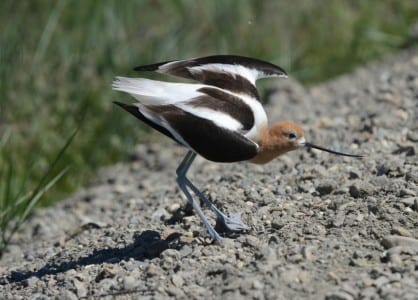
These are nesting birds at the Great Salt Lake and this male is feigning stupidity (or some such) to protect his young. This behavior is found in many ground-nesting species from shorebirds to nighthawks. Note the brown neck and head that they gain in March before leaving the coast for places such as the Great Salt Lake. Males have less of a bend in their bill (which means the female has more curves…).
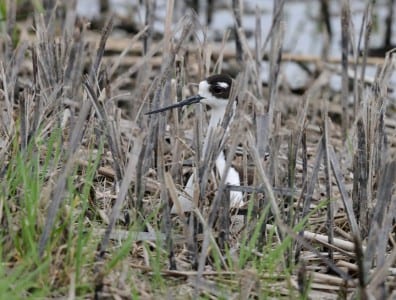
Stilts are residents on the UTC but are scarce just before the breeding season in many places. They lack the color of the breeding avocets, being black and white (with bubblegum-colored legs). Note the straw-like bill for sucking up plankton and insect larvae. Walking past, this bird would be hard to spot.
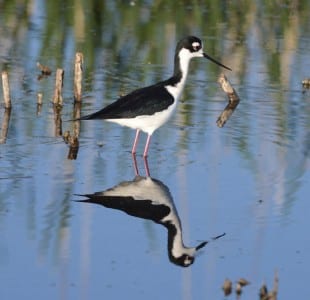
Sexual dimorphism is often a subtle thing. This is a male stilt because he is black on the back (females are bronzy). With avocets it was the curvature of the beak. Sandpiper sexes are often separated by the length of the bill. Male plovers are larger than females but male sandpipers are smaller than their female counterparts. But one sure way to tell is…
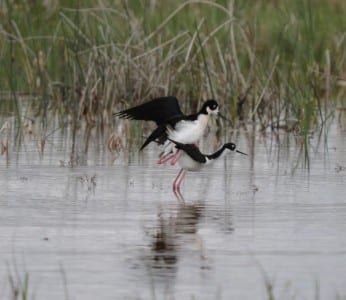
The male is always on top during sex. And yes, with birds which have long legs, they do get in the way while mating. They will mate a few times and then when she “knows” she’s with egg <grin> she won’t stand for him any longer. My mind is racing with lowclass anthropomorphisms.
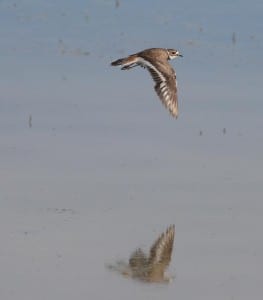
Photographers love to shoot birds on reflection, especially flight shots. And usually better ones than this. But this is a Killdeer flying along the shores of Salt Lake, p robably with eggs somewhere. Note the wingstripe most plovers have, as well as most sandpipers and the oystercatchers which are light underneath. But not Recurvirostridae, the stilts and avocets. I wonder why!
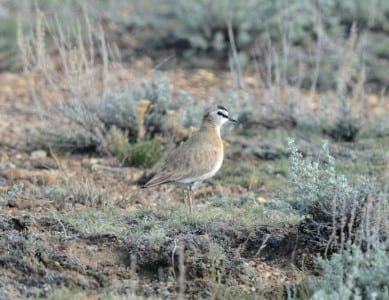
One of the hardest birds to find in the breeding season is the rare Mountain Plover. First of all, they don’t nest in mountains, but rather high plains. Second, they are wary on their winter grounds in places like North Texas and California, and they don’t stop a lot inbetween. And I might add that the spot I show them to my clients in Montana is a slick road, and impassible in 2012. (Nailed em this year, tho!)
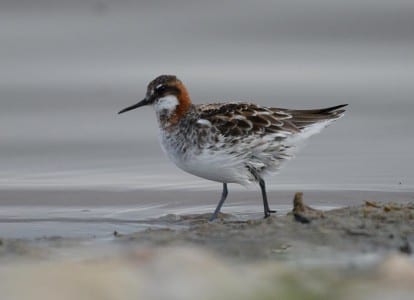
This is the real Red-necked Phalarope, not the one some people call the female Wilson’s, with her reddish neck stripe. These are smaller, stockier and darker. Any time you folks with cameras get a chance to take a shot from ground level, do it! It’s a very pleasing image, making the bird stand out. And phalaropes are ridiculously tame, as they spend the balance of the year at sea, not learning what awful things people are capable of.
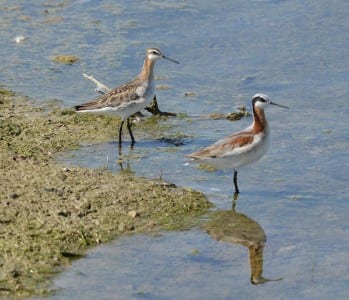
Now here is a pair of Wilson’s Phalaropes, a species seen scattered over much of the East. With all phalaropes, the females are more colorful and they sometimes have more than one mate.* Note the long, needle-like bill for sucking up larvae and water, p lus the males probably suck up to the females… * As time marches on, scientists are learning that fewer and fewer birds are really monogamous. Males sneak around, but we are finding that females do far more than we thought. The genetic var iation strengthens the species, so bonding becomes a seasonal thing. We hope that people work differently, with some honor and commitment, but there are exceptions, apparently.
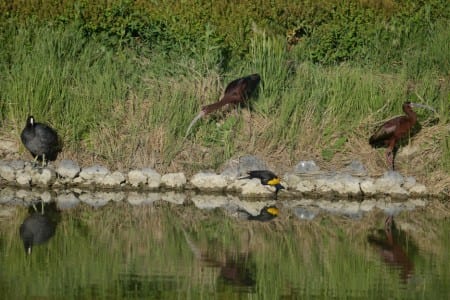
Many birds are tied to the water, partially or wholly. Here you see a coot, Yellow-headed Blackbird and two White-faced Ibis coming down to drink at the freshwater saloon. If you are providing CLEAN water for your neighborhood birds, you are really helping them survive the increasingly brutal summers. (BTW, it was (again) shirtsleeve weather here on the Arctic Ocean today.) Global warming is affecting higher latitudes like the Arctic more than temperate ones like where you likely live, and even less in the Tropics.

 Posted in
Posted in 
























